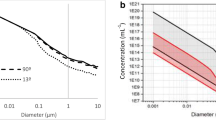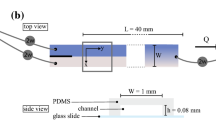Abstract
Objective
This work compares the measured \({{R}_{2}^*}\) of magnetic nanoparticles to their corresponding theoretical values in both gel phantoms and dynamic water flows on the basis of the static dephasing theory.
Materials and methods
The magnetic moment of a nanoparticle solution was measured by a magnetometer. The \({{R}_{2}^*}\) of the nanoparticle solution doped in a gel phantom was measured at both 1.5 and 4.7 T. A total of 12 non-steady state flow experiments with different nanoparticle concentrations were conducted. The \({{R}_{2}^*}\) at each time point was measured.
Results
The theoretical \({{R}_{2}^*}\) on the basis of the magnetization of nanoparticles measured by the magnetometer agree within 11% of MRI measurements in the gel phantom study, a significant improvement from previous work. In dynamic flow experiments, the total \({{R}_{2}^*}\) calculated from each experiment agrees within 15% of the theoretical \({{R}_{2}^*}\) for 10 of the 12 cases. The MRI phase values are also reasonably predicted by the theory. The diffusion effect does not seem to contribute significantly.
Conclusions
Under certain situations with known \({{R}_{2}^*}\) , the static dephasing theory can be used to quantify the susceptibility or concentration of nanoparticles in either a static or dynamic flow environment at a given time point. This approach may be applied to in vivo studies.
Similar content being viewed by others
References
Bowen CV, Zhang X, Saab G, Gareau PJ, Rutt BK (2002) Application of the static dephasing regime theory to superparamagnetic iron-oxide loaded cells. Magn Reson Med 48: 52–61
Lebel RM, Menon RS, Bowen CV (2006) Relaxometry model of strong dipolar perturbers for balanced-SSFP: application to quantification of SPIO loaded cells. Magn Reson Med 55: 583–591
Brown RJS (1961) Distribution of fields from randomly placed dipoles: free-precession signal decay as result of magnetic grains. Phys Rev 121: 1379–1382
Yablonskiy DA, Haacke EM (1994) Theory of NMR signal behavior in magnetically inhomogeneous tissues: the static dephasing regime. Magn Reson Med 32: 749–763
Bjørnerud A, Johansson L, Briley-Saebø K, Ahlström H (2002) Assessment of T1 and T2* effects in vivo and ex vivo using iron oxide nanoparticles in steady state—dependence on blood volume and water exchange. Magn Reson Med 47: 461–471
van Osch M, Vonken E, Viergever M, van der Grond J, Bakker C (2003) Measuring the arterial input function with gradient echo sequences. Magn Reson Med 49: 1067–1076
Wismer GL, Buxton RB, Rosen BR, Fisel CR, Oot RF, Brady TJ, Davis KR (1988) Susceptibility induced MR line broadening: applications to brain iron mapping. J Comput Assist Tomogr 12(2): 259–265
Li D, Wang Y, Waight DJ (1998) Blood oxygen saturation assessment in vivo using \({T_{2}^*}\) estimation. Magn Reson Med 39: 685–690
Silvennoinen MJ, Clingman CS, Golay X, Kauppinen RA, van Zijl PCM (2003) Comparison of the dependence of blood R 2 and \({{R}_{2}^*}\) on oxygen saturation at 1.5 and 4.7 Tesla. Magn Reson Med 49: 47–60
Cheng Y-CN, Haacke EM, Yu Y-J (2001) An exact form for the magnetic field density of states for a dipole. Magn Reson Imaging 19(7): 1017–1023
Greil G, Geva T, Maier S, Powell A (2002) Effect of acquisition parameters on the accuracy of velocity encoded cine magnetic resonance imaging blood flow measurements. J Magn Reson Imaging 15: 47–54
Ramnath HP (2006) Quantification of velocity and tracking micron sized particles using MRI and CFD. M.S. thesis, Wayne State University Detroit
Gillis P, Koenig SH (1987) Transverse relaxation of solvent protons induced by magnetized spheres: application to ferritin, erythrocytes, and magnetite. Magn Reson Med 5: 323–345
Ziener CH, Bauer WR, Jakob PM (2005) Transverse relaxation of cells labeled with magnetic nanoparticles. Magn Reson Med 54: 702–706
Ziener CH, Kampf T, Melkus G, Herold V, Weber T, Reents G, Jakob PM, Bauer WR (2007) Local frequency density of states around field inhomogeneities in magnetic resonance imaging: effects of diffusion. Phys Rev E 76: 031915
Marques JP, Bowtell R (2005) Application of a Fourier-based method for rapid calculation of field inhomogeneity due to spatial variation of magnetic susceptibility. Concepts Magn Reson B (Magn Reson Eng) 25B(1): 65–78
Condon EU, Odishaw H (1958) Handbook of Physics, McGraw-Hill, New York, pp 4–128
Bozorth RM (1951) Ferromagnetism. Van Nostrand, Princeron
Jackson JD (1999) Classical Electrodynamics. Wiley, New York
Author information
Authors and Affiliations
Corresponding author
Rights and permissions
About this article
Cite this article
Shen, Y., Cheng, YC.N., Lawes, G. et al. Quantifying magnetic nanoparticles in non-steady flow by MRI. Magn Reson Mater Phy 21, 345–356 (2008). https://doi.org/10.1007/s10334-008-0140-4
Received:
Revised:
Accepted:
Published:
Issue Date:
DOI: https://doi.org/10.1007/s10334-008-0140-4




